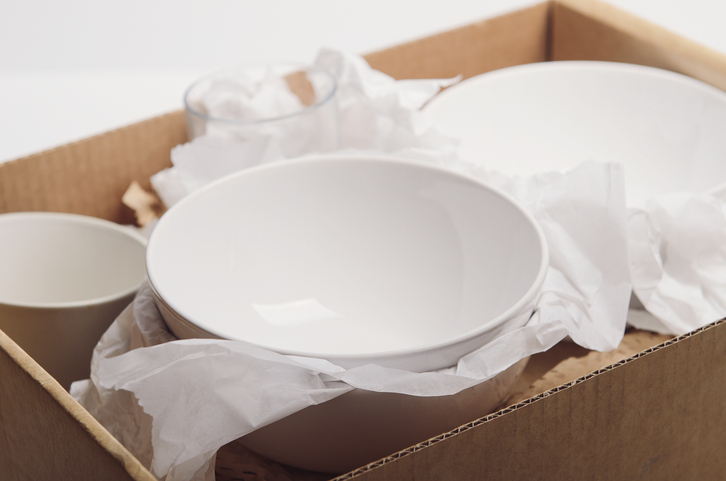Deciding how to pack dishes when moving can be a difficult task. You want to make sure they’re packed safely and securely but also want to maximize the space in your boxes.
It can take a long time to properly pack your dishes for a move, but these tips and tricks will make the packing process go smoothly. You can also call a national moving company to help assist you with the packing process.
Reinforce the Bottom of Your Box
Before you put a single dish inside a packing box, you need to reinforce the bottom of the box with packing tape.
Dishes are heavy, and if you don’t reinforce the bottom of the box, there is a chance the bottom will break when you pick the box up, and all your dishes will fall out the bottom.
Add an extra two or three strips of packing tape along the bottom seam of your box for extra strength.
Sort Your Dishes
The most efficient way to pack dishes for a move is to put similar items in the same box.
Before you start wrapping your dishes, sort them into piles of plates, mugs, bowls, etc. This will help you stay organized as you start packing.
Add Padding to the Bottom of Your Boxes
To protect your dishes, you should add packing material to the bottom of your box. Putting crumpled paper at the bottom of your box works best, but you can use a thin towel or bubble wrap.
This added layer of protection prevents the bottom of your dishes from getting chipped or broken in the move.
Wrap Each Dish Individually
It takes a little extra time and effort, but the best way to ensure your dishes make it your new home without breaking is by wrapping each dish individually.
You should use either plain brown or while packing paper or newspaper to wrap your dishes.
For extra security, you can use a piece of tape to keep the paper sealed on each dish, but it isn’t necessary. Your dishes will be tightly packed in the box and will hold the paper in place.
Put Heavy Items on the Bottom
You should always put the heaviest items on the bottom of your boxes when packing, and this rule applies to dishes as well.
Putting the heavy items on the bottom of your boxes builds a solid base for the next layer of items, makes the boxes easier to lift, and prevents lighter items from being squished and broken by heavier items on top of them.
Items like plates and bowls tend to be the heaviest dishes and should be put at the bottom of your boxes.
Wrap Glasses Properly
Glasses are incredibly delicate. You need to wrap them properly, or they will get damaged in the move.
Place a piece of packing paper on a flat surface. Put one of your glasses in one of the corners at an angle and start to slowly roll the glass.
When you reach the end, stuff the extra paper at the top of the glass inside it to protect it.
Pack Plates Vertically
When you start brainstorming how to pack dishes when moving, your instinct may tell you to pack plates flat, but they should actually be packed vertically.
By standing the plates on their sides in the box, they’re able to better support one another. You can pack the plates tightly and eliminate any unnecessary movement in the box.
Wrap the Stem of Wine Glasses Separately
Wine glass stems are very delicate, and they need extra care and attention during the packing process.
You should wrap the stems of your wine glasses with a folded sheet of paper and then wrap the entire wine glass with a piece of packing paper.
Be Careful When Packing Knives
There is a specific process you need to follow to properly and safely pack knives for a move.
Start by wrapping your knives in packing paper. Only the blade should be wrapped. The handles should be outside the packing paper.
Then wrap the packing paper with the blades and the handle of the knives in a kitchen towel.
Finally, add a second layer of packing paper around the towel and seal it with packing tape. Label the package clearly, so you know it contains knives when you’re unpacking.
Pack Essential Items Separately
It takes the average person 182 days to completely unpack after a move. To save you frustration the first few days you’re in your new home, you should pack a box of essential dishes.
For every person in your household, the box should include:
- Plate
- Bowl
- Glass
- Cutlery
- Coffee mug
You should also pack a pot, mixing bowl, and small utensils like a spatula in this box.
Basically, you need to be able to live off the items in this box for about a week so include anything you know you’ll need to use shortly after you arrive at your new home.
Also Read: How to pack lamps for a move
Add Padding Before Closing
After you’ve filled your box with dishes, fill in any empty spaces with packing paper, towels, or bubble wrap to prevent the dishes from moving during transit.
You should also add a layer of packing material on top of your dishes before you close the box.
Mark Boxes as Fragile
You need to clearly mark the boxes as fragile, so your movers know to take extra care when moving the boxes.
You should mark every side of the box with ‘fragile’ in large writing and indicate what side of the box is up, so it isn’t placed upside down in the moving truck.
Also Read: How to pack for a move
Conclusion
Packing dishes for a move can be time-consuming, but it is worth the effort. Taking the time to individually wrap every dish helps ensure they make it to your new home unbroken.
We hope that these packing tips will help with an easier moving process.





